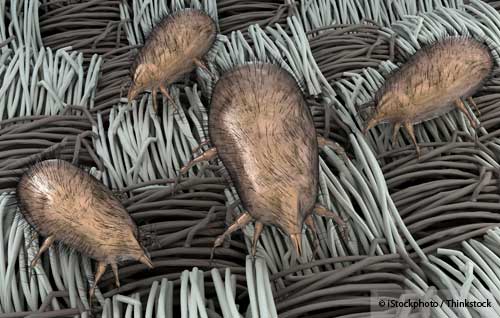written by By Dr. Becker
House Dust Mites Can Drive Your Cat or Dog Nuts
Dust mite allergies are extremely common among dogs and cats (and humans), but because house dust mites are microscopic, many pet owners think they couldn’t possibly present much of a problem.But the fact is when we decided to bring pets into our homes and onto our furniture and beds, we increased their exposure to these mites. Over time, our dogs and cats have become sensitized to the little critters just as we have.
House Dust Mites
Dermatophagoides farina and Dermatophagoides pteronyssinus, more commonly known as dust mites, are found in materials like carpeting, upholstered furniture, mattresses, bedding, and cloth toys. They thrive in warm, moist air (the kind we exhale during sleep) and darkness -- which is why they are often found in bedding. Their bodies are translucent.Dust mites survive on a diet of dead skin, bacteria, fungi and viruses in the environment. They prefer to feed on the skin of hypersensitive (allergic) individuals because the lipids in their skin are different from those of non-allergic people.What makes dust mites allergenic for pets and people is a protein found in their feces.
Symptoms of Dust Mite Allergies in Your Pet
Because house dust mites are a problem year-round, allergies to them tend not to be seasonal. However, they are known to be worse in the spring and fall.From 30 to 80 percent of allergic dogs and cats test positive for dust mite sensitivity. Pets that once lived primarily outdoors can develop sensitivity after they’ve lived indoors for a period of time.In dogs, signs of a dust mite allergy include bacterial skin infections; itching, especially around the face and on the feet; recurrent ear inflammation or infections; and seborrhea (a red, itchy rash with white scales).Kitties with a dust mite allergy may develop something called eosinophilic granuloma complex that results in skin lesions; itching; acne on the chin; recurrent ear inflammation or infections; and a disease of the foot pads called plasma cell pododermatitis, or “pillow foot.”
Diagnosing and Treating Dust Mite Allergies
Your vet will look for a history that indicates your pet’s condition is non-seasonal, and is not related to either food sensitivities or skin parasites. Next your dog or cat should be either skin or serum-tested for sensitivity to dust mites.Once your pet has a confirmed diagnosis of dust mite allergy, I recommend first trying to rid his environment of mites. This is a bit of a challenge, because studies show the most effective method of treatment is to air out fabrics your pet is exposed to on either a hot, sunny or cold dry day for 12 hours, then vacuuming.Other suggestions include:
- Switching to mattress covers made of micro-porous fabric (“dust mite” covers)
- Covering your pet’s bed in a sheet that repels dust mites and washing it weekly
- Washing bedding in hot water at least monthly, or in cold water and tea tree oil
- Removing carpets from bedrooms
- Vacuuming all carpets and upholstery often (at least weekly) using a vacuum with a HEPA filter
- Steam cleaning mattresses, pet bedding and upholstered furniture
Many veterinarians recommend immunotherapy (allergy shots or under-the-tongue drops). This is a much safer option than immuno-suppressant drugs like cyclosporine or corticosteroids. I prefer to hold off on powerful drugs that shut down the immune system in favor of dealing with the animal’s environment first, in conjunction with some other safe, common sense steps. These include regular foot soaks and bathing to wash away allergens and soothe irritated skin; feeding a species-appropriate, anti-inflammatory diet; providing fresh, good quality drinking water; and avoiding over-vaccinating/over-medicating to insure your pet’s immune system remains strong and resilient.You can also consider investing in an air purifier to control dust mites, and switching to non-toxic cleaning agents to lessen your pet’s overall toxic load.Keep in mind it only takes a miniscule amount of dust mite allergen to create an allergic response in your dog or cat. So the more effective your mite eradication efforts, the more comfortable your allergic pet will be.

No comments:
Post a Comment